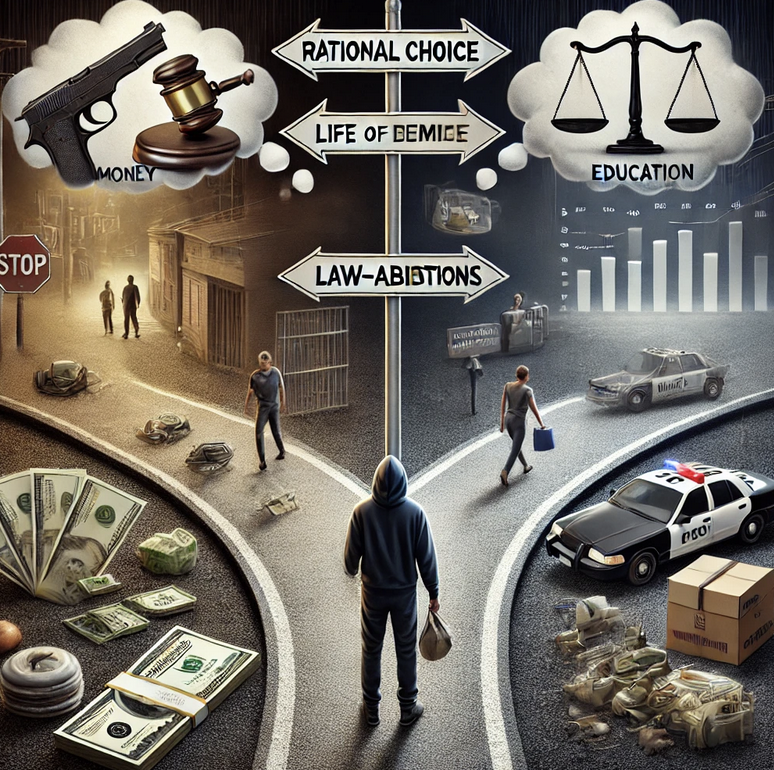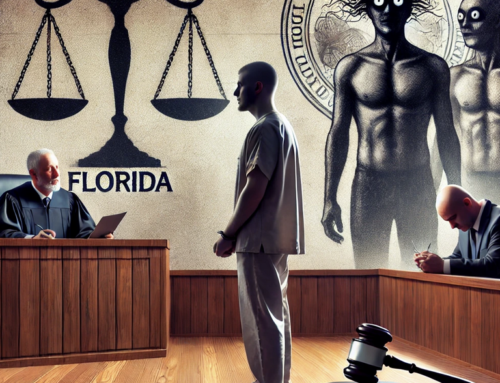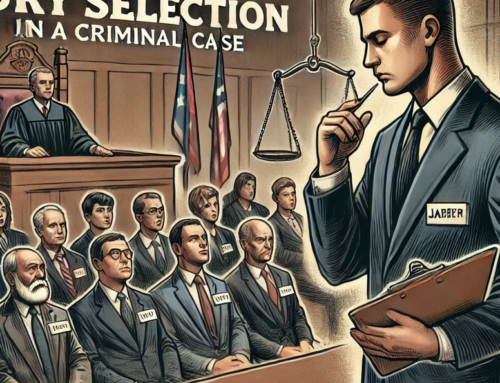Rational choice is a prominent theoretical model in many fields of research, though many criminologists continue to doubt its applicability as a general theory of crime. Much of this skepticism can be attributed to the over-simplification of the model, and the methodologies utilized when testing it in research. Rational choice theory is conceptually broader than many researchers believe it to be, and those who explore it often leave out important variables in their testing. Numerous studies have been conducted, the findings of which have legitimized rational choice as a general theory of crime. The ability to apply rational choice theory not only to instrumental criminal acts, but also to those crimes in which there is no apparent monetary motive, has been supported through research. The goal of this article is to thoroughly explain Gary Becker’s original model of rational choice theory and to take a closer look at how it is currently utilized today in criminological research. In addition to highlighting the positive aspects of the model, its shortcomings will also be explained.
Criminology is the scientific study of crime and its origins. Criminologists seek to answer important questions: Why do certain people commit crimes and not others? Why do criminals often specialize in the crimes they commit? Can criminal activity be predicted? How can crime be prevented? At first glance these questions may seem relatively straightforward, but coming up with accurate answers is a complex task, and determining which of the theories and methodologies is best equipped to help do so is still up for debate. Rational choice theory (RCT), which is a prominent theoretical model in many fields of research, can be applied to the study of crime. Many criminologists doubt its applicability as a general theory of crime, though much of this skepticism can be attributed to confusion and over-simplification of the model, and the narrow range of variables and methodologies that are often utilized when testing it in research. The original RCT of crime, which is based on Gary Becker’s (1968) economic model of crime, will be thoroughly explained in the paragraphs that follow; empirical studies that have tested its applicability in the field of criminology will be examined with regards to the methodologies that were used and their limitations.
Rational choice theory is a core theoretical model in the fields of political science, economics, sociology, and psychology, yet many criminologists continue to doubt its applicability as a general theory of crime. Some critics claim that RCT, which is a theory that highlights the rational weighing of the pros and cons of a certain action, is suitable in other fields like economics but may be limited to property crimes or other instrumental acts that may result in financial gain. Other critics claim that RCT fails to incorporate the theoretical constructs that are highlighted in other theories of crime, though in many cases this has turned out to be inaccurate. When rational choice is tested in research, experimental designs may only consider the formal sanction variables (risk) while failing to consider other factors that influence utility (reward).
Gary Becker (1968), a proponent of the rational choice model, outlined the formula below, which can be used to determine a potential criminal offender’s utility:
EU = pU (Y– f) + (1 – p) U (Y) (1)
According to equation 1, p represents the potential offender’s likelihood of being caught; f is the severity of the sanction (punishment) if apprehended; Y represents the utility benefits one gains after successfully committing the crime and without being caught. In other words, this choice calculus describes an individual’s utility as a function of the costs and benefits of crime; crime should rise in Y and fall for both p and f.
Deterrence theory, which emphasizes the role that formal and informal sanctions play in the prevention of crime, is often positioned right next to RCT in the literature and they are sometimes used interchangeably in empirical research. While the constructs are similar, rational choice theory is conceptually broader than a test of deterrence, which is only concerned with risk and cost components of rational choice. The following paragraphs include a literature review of the three components of rational choice. Most of these studies are only concerned with individual components of RCT, and so technically speaking, they are only tests of deterrence. Regardless, when taken together, empirical support for each of the three components should be seen as evidence that rational choice theory can be reliably used as a general theory of crime.
One of the most heavily researched variables of rational choice in criminology is the probability of apprehension (p) and how it relates to crime prevention. Research suggests a negative relationship between crime and police presence, increases in police manpower, and hot spot and problem-oriented policing. Tests of subjectivity on risk can also be found in the literature. Researchers have found evidence that subjective risk perception is in a constant flux of change that is rationally updated when an individual is exposed to new information; this has been demonstrated in samples of serious offenders, high-risk youth and in the general population. Other scholars have taken it a step further, finding evidence to suggest emotion plays significant role in subjective perception of risk and rational decision making; this is just one example that can be used to counter critics’ claims that RCT is too rational to harmonize with other theoretical models; each component of rational choice is arguably influenced by many other variables that can be found in other theoretical models of crime. Most criminological studies are strictly concerned with risk perceptions while failing to consider an individual’s risk preferences, and this is a limitation in much of the existing research.
The next component of Becker’s (1968) model, which has to do with the severity of punishment (f), has also been given considerable attention by researchers. Most of these studies have operationalized severity in terms of longer prison sentences, the results of which have been mixed. These inconsistent results have led to controversy in the field of criminology; critics claim this should be seen as definitive proof that rational choice is not a reliable theory of crime. These conclusions that can be drawn from these studies are limited. Not only did they fail to consider an interaction between severity and certainty (which is essential in a true test of RCT), but they did not entertain other informal costs of crime that have been supported empirically, such as embarrassment, guilt or shame. Capital punishment, arguably the most severe formal sanction there is, has been heavily researched and most criminologists agree that it is not an effective deterrent to crime. Other factors that are not frequently considered by researchers must be at play. In other words, f is composed of both formal and informal sanctions, and the results stemming from any study that fails to consider these other variables should not be seen as conclusive evidence that RCT is unreliable.
The next component Y, draws the largest distinction between deterrence and rational choice studies. Deterrence theorists are strictly concerned with factors that might discourage an individual from breaking the law, while failing to consider the beneficial aspects of what one might gain. Even in deterrence studies that consider both the certainty and severity components, failing to consider the benefits of crime (Y) and whether or not there are any interactions with the other two, should be seen as a major limitation that leads to a fragmentary test of RCT at best. Many critics of RCT claim it is only applicable to property or white-collar crimes that involve potential monetary benefits, but research shows other informal returns that can be applied to other crimes may also play a role, such as a gain in social status or intrinsic enjoyment.
Many studies have found evidence of a negative relationship between employment rates and wages with crime; this might lead criminologists to support the inclusion of net benefit when testing RCT, which consists of total gain minus the opportunity cost of time spent in criminal activity. Taking this into account, one might further argue that crime is costly not only through risk of apprehension and imprisonment, but because time that could have otherwise been used to benefit oneself legally is lost. With regards to net benefit, a potential offender making minimum wage might give more weight to the Y component of a robbery, than someone who earns a six-figure salary. Similarly, components of risk (p and f) might be more heavily weighed by the six-figure earner; not only do they risk getting caught and sent to prison, but they also risk losing their job and that stream of income. One empirical study found evidence for a similar conclusion, which found those individuals who had higher legal earnings had a greater likelihood of refraining from criminal activity in the future. The same individual in one situation might make completely different choices if placed into other circumstances.
As demonstrated throughout the paper, many of the conclusions that have been made by critics of rational choice theory are based on results stemming from studies that investigated one narrowly defined component of the model. A study on the relationship between risk perception and crime or deterrence and prison-sentence length are only partial models of RCT, and don’t allow for comparison of the effects of different components or the ability to observe changes as a result of interaction. Matsueda (2013) does an excellent job at outlining rational choice theory, and highlights the importance for inclusion of all three components and a wide range of variables in any measure of utility:
Using the above summary as a guideline, it can be safely be argued that much of the literature that claims to test rational choice theory has many limitations, which not only prevent its critics but also its proponents, from forming accurate conclusions regarding its applicability as a general theory of crime. This is not to say that all published studies failed to consider multiple components of Becker’s (1968) rational choice model, but the majority did.
In one study that was conducted on North Carolina ex-convicts, researchers found that increases in certainty of apprehension (p) and severity of punishment (f) reduced the likelihood of participation in future criminal activity; it was also found that certainty had a much larger impact on criminal activity when compared to severity, which is in line with research on deterrence. Additionally, a small effect was found between higher legal earnings and lower chance of future crime. In another study that was conducted on adult criminals, adult addicts and youths, researchers found criminal activity was related to the anticipated rewards of offending (Y) but not to the costs . In this study, a range of formal and informal costs of punishment was considered, along with measures of both legal and illegal earnings . These findings could be interpreted as evidence that perceived rewards of offending are more heavily weighted in the decision making process, a factor that tests of deterrence completely fail to account for and may explain the mixed results that are cited by critics of RCT. One study found earnings from criminal activity were positively associated to drug use, criminal activity and arrest; on the other hand, they were inversely related to conventional employment and ties to family or friends. While these above-mentioned studies were a step in the right direction, neither of them included other components of the rational choice model, such as perceived informal costs or expected intrinsic rewards. Researchers Matsueda et al. (2006) found offending was negatively associated to an increased perceived risk of arrest and positively associated to perceived psychic rewards, such as expected excitement or coolness of the criminal act. While this study did include some of the components that other experimental models of rational choice were lacking, they failed to consider informal costs or net benefit as a factor.
Many of these studies provide support for multiple components of the rational choice model, and when taken together this may be interpreted as substantive evidence that rational choice theory can be reliable and accurate in the field of criminology. Any individual with a complete understanding of RCT should know that each component has an effect on the other; excluding any one component in testing has the possibility of completely changing the resulting perceived utility of the criminal act. The goal of this article was to not only inform the reader of some positive attributes of RCT, but also to highlight its shortcomings in the current literature. Skeptics of rational choice theory should reconsider their position until more comprehensive tests that include all components of Becker’s (1968) model can be conducted. Just as it has already demonstrated in other fields of research, rational choice has the potential to help answer many of those important questions in the field of criminology.








